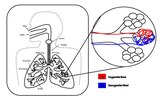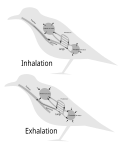Gas exchange
Exchange of gases or gas exchange is carried out by organisms. Animals breathe out carbon dioxide and breathe in oxygen. Plants use carbon dioxide to carry out photosynthesis, making oxygen. Plants only do this when there is light. Plants breathe day and night.
Humans
In the human respiratory system, gas exchange happens in the alveolus (alveoli for plural). These are in the lungs and help with diffusion. Oxygen diffuses into the bloodstream, from the air. Oxygen is used in aerobic respiration. Carbon dioxide diffuses out of the bloodstream, into the air. Carbon dioxide is a waste product made by respiration.[1]
Eukaryotes
In eukaryotes, respiration is carried out by the mitochondria. However, in some cells it is carried out by the cytoplasm.[2] For more information visit cellular respiration.
Gas Exchange Media
Fig. 5. The changes in the composition of the alveolar air during a normal breathing cycle at rest. The scale on the left, and the blue line, indicate the partial pressures of carbon dioxide in kPa, while that on the right and the red line, indicate the partial pressures of oxygen, also in kPa (to convert kPa into mm Hg, multiply by 7.5).
References
- ↑ Kety S.S. 1951. The theory and applications of the exchange of inert gas at the lungs and tissues. Pharmacological Reviews 3 (1): 1–41. [1]
- ↑ "Cellular Respiration: What Is It, Its Purpose, and More". Osmosis. Retrieved 2025-05-21.





